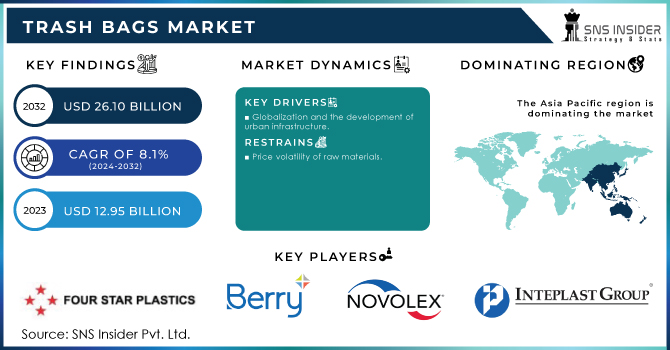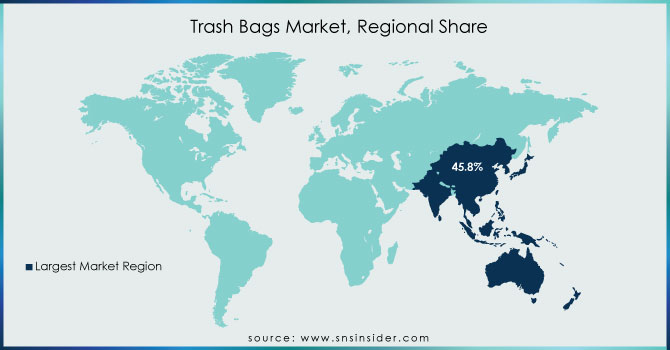Trash Bags Market Report Scope & Overview:

Get More Information on Trash Bags Market - Request Sample Report
The Trash Bags Market size was USD 12.95 billion in 2023 and is expected to Reach USD 26.10 billion by 2032 and grow at a CAGR of 8.1% over the forecast period of 2024-2032.
As the urban population continues to grow, the demand for garbage bags also increases due to a higher rate of waste generation. Urbanization often leads to changes in lifestyles and consumption patterns, contributing to an increase in waste. In turn, this reinforces the need for durable and reliable trash bags capable of holding different amounts of waste.
Environmental concerns also have a significant impact on the trash bag market. Consumers and regulators increasingly emphasize the importance of responsible waste management to minimize environmental impact. Therefore, there is a growing demand for eco-friendly and biodegradable garbage bags in line with the goal of sustainable development.\
Additionally, advances in technology have led to the development of innovative trash bag designs. Odor control features, antibacterial properties and advanced sealing mechanisms are some examples of innovations that have enhanced the market's attractiveness. Such features address common problems such as unpleasant odors and potential leaks, improving the overall user experience.
The retail sector plays an important role in the distribution of garbage bags. They are available in different sizes, strengths and types to meet different customer needs. From small kitchen trash bags to large industrial waste bags, the market offers a wide variety to choose from.
Global economic trends are also affecting the trash bag market. The level of disposable income affects consumers' preferences for convenience and quality, which in turn affects their choice of garbage bags. In addition, industries that require a waste management solution are contributing to the increased demand for larger and sturdier garbage bags.
In recent times, the COVID-19 pandemic has highlighted the importance of hygiene and sanitation, increasing the demand for garbage bags, especially in healthcare facilities and residential areas. The lifestyle changes caused by the pandemic, with more people working from home, have led to changes in waste generation patterns and subsequently affected demand for garbage bags.
MARKET DYNAMICS
KEY DRIVERS:
-
Health and Safety Regulations
The stringent health and safety legislation requires the proper collection and disposal of waste within industry, e.g., healthcare or food services. This results in a corresponding demand for special garbage bags that comply with these requirements.
-
Globalization and the development of urban infrastructure.
RESTRAIN:
-
Price volatility of raw materials
Due to factors such as supply chain interruptions, geopolitical issues and market fluctuations, raw material prices used for the production of garbage bags like plastics or resins may be volatile. This will have a bearing on the costs of production and subsequent pricing strategies.
-
Mismanagement and improper disposal.
OPPORTUNITY:
-
Education and awareness campaigns to promote the proper disposable of waste
Demands for good quality trash bags and encouraging the proper use of these may be stimulated by education campaigns to inform consumers, businesses and municipalities on sound waste management practices.
-
The rising emphasis on sustainability has opened doors for the development of advanced ecofriendly garbage bags made from biodegradable materials.
CHALLENGES:
-
Mismanagement of Waste
Insufficient waste disposal practices can lead to litter, environmental pollution and problems with waste management systems, even with the right trash bags.
IMPACT OF RUSSIAN UKRAINE WAR
The war caused the price of raw materials used to make garbage bags, such as polyethylene, soar. This is due to supply chain disruptions and growing demand for these materials from other industries. In the United States, the price of polyethylene has increased by 15% since the beginning of the war. The Asia-Pacific region is the largest consumer of garbage bags, accounting for more than 45% of global demand. The war also disrupted demand in the region. According to research by SNS Insider, it was found that the demand for garbage bags in the European Union fell 2% in the first quarter of 2023.
IMPACT OF ONGOING RECESSION
Recessions often lead to a decrease in consumer spending. This is because people have less disposable income to spend on non-essential items, like garbage bags. A study by the National Retail Federation found that consumer spending fell 0.8 percent in the first quarter of 2023. The unemployment rate in the U.S. hit 5.5% in June 2023. The price of polyethylene, a material commonly used to make garbage bags, increasing by 10% in the first half of 2023. The demand for garbage bags is also influenced by factors such as population growth and urbanization. These factors will continue to increase in the coming years, which could offset some of the negative effects of the recession. The trash bag market is relatively price-sensitive, so even a slight increase in prices could cause demand to drop.
KEY MARKET SEGMENTS
By Type
-
Star Sealed Trash Bags
-
Flat Trash Bags
-
Drawstring Trash Bags
-
Flat Star Sealed Trash Bags
-
Zipper Bags
-
T-Shirt Trash Bags
-
Others
By Capacity
-
10-50 Kg
-
50-100 Kg
-
100-150 Kg
-
More Than 150 Kg
By Distribution Channel
-
Supermarkets
-
Specialty Stores
-
E-commerce
-
Convenience Stores
-
Others
By End User
-
Institutions
-
Hospitals
-
Laboratories
-
Residential
-
Corporate Office
-
Industries
-
Others
REGIONAL ANALYSIS
Asia Pacific dominated the trash bags market with the largest market share of 45.80%. The rising disposable incomes along with the growth of the economies of countries such as India and China are driving the market growth. The increased us of garbage bags, and strict rules and regulations regarding waste management have additionally given market growth.
European region is the second largest market for the trash bags. Increasing sustainability and stringent government rules have significantly increased the market growth. Germany holds the largest market share in this region, and Canada trash bags market is the fastest growing market over the forecast period.
North American region is the fastest growing market for the trash bags. Laws against disposable of waste, have given growth to the market. The laws have given growth to the sustainable and biodegradable bags.

Get Customized Report as per Your Business Requirement - Request For Customized Report
REGIONAL COVERAGE:
North America
-
US
-
Canada
-
Mexico
Europe
-
Eastern Europe
-
Poland
-
Romania
-
Hungary
-
Turkey
-
Rest of Eastern Europe
-
-
Western Europe
-
Germany
-
France
-
UK
-
Italy
-
Spain
-
Netherlands
-
Switzerland
-
Austria
-
Rest of Western Europe
-
Asia Pacific
-
China
-
India
-
Japan
-
South Korea
-
Vietnam
-
Singapore
-
Australia
-
Rest of Asia Pacific
Middle East & Africa
-
Middle East
-
UAE
-
Egypt
-
Saudi Arabia
-
Qatar
-
Rest of Middle East
-
-
Africa
-
Nigeria
-
South Africa
-
Rest of Africa
-
Latin America
-
Brazil
-
Argentina
-
Colombia
-
Rest of Latin America
Key Players
Some major key players in the Trash Bags market are Four Star Plastics, Berry Global Inc, Novolex, International Plastics Inc, Inteplast Group Ltd, The Clorox Company, Poly America LP, Reynolds Consumer Products, Cosmoplast Industrial Company, Alpha Omega Plastic Manufacturing LLC and other players.
RECENT DEVELOPMENT
-
As from July 1, 2022, businesses in India will have to comply with new rules on plastic waste management that ban single use plastics.
-
In a deal to increase six production plants and continue its expansion, Novolex acquires Heritage Bag.
| Report Attributes | Details |
| Market Size in 2023 | US$ 12.95 Bn |
| Market Size by 2032 | US$ 26.10 Bn |
| CAGR | CAGR of 8.1 % From 2024 to 2032 |
| Base Year | 2023 |
| Forecast Period | 2024-2032 |
| Historical Data | 2020-2022 |
| Report Scope & Coverage | Market Size, Segments Analysis, Competitive Landscape, Regional Analysis, DROC & SWOT Analysis, Forecast Outlook |
| Key Segments | • by Type (Star Sealed Trash Bags, Flat Trash Bags, Drawstring Trash Bags, Flat Star Sealed Trash Bags, Zipper Bags, T-Shirt Trash Bags, Others) • by Capacity (10-50 Kg, 50-100 Kg, 100-150 Kg, More Than 150 Kg) • by Distribution Channel (Supermarkets, Specialty Stores, E-commerce, Convenience Stores, Others) • by End User (Institutions, Hospitals, Laboratories, Residential, Corporate Offices, Industries, Others) |
| Regional Analysis/Coverage | North America (US, Canada, Mexico), Europe (Eastern Europe [Poland, Romania, Hungary, Turkey, Rest of Eastern Europe] Western Europe] Germany, France, UK, Italy, Spain, Netherlands, Switzerland, Austria, Rest of Western Europe]), Asia Pacific (China, India, Japan, South Korea, Vietnam, Singapore, Australia, Rest of Asia Pacific), Middle East & Africa (Middle East [UAE, Egypt, Saudi Arabia, Qatar, Rest of Middle East], Africa [Nigeria, South Africa, Rest of Africa], Latin America (Brazil, Argentina, Colombia Rest of Latin America) |
| Company Profiles | Four Star Plastics, Berry Global Inc, Novolex, International Plastics Inc, Inteplast Group Ltd, The Clorox Company, Poly America LP, Reynolds Consumer Products, Cosmoplast Industrial Company, Alpha Omega Plastic Manufacturing LLC |
| Key Drivers | • Health and Safety Regulations • Globalization and the development of urban infrastructure. |
| Key Restraints | • Price volatility of raw materials |

